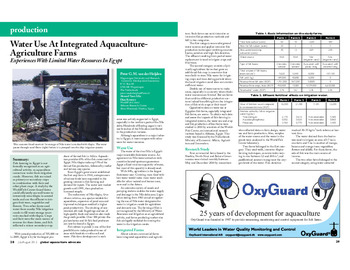Please use this identifier to cite or link to this item:
https://hdl.handle.net/20.500.12348/1014
Water use at integrated aquaculture-agriculture farms: experiences with limited water resources in Egypt
| dc.creator | van der Heijden, P.G.M. | |
| dc.creator | Nasr-Alla, A.M. | |
| dc.creator | Kenawy, D. | |
| dc.date.accessioned | 2018-09-27T09:41:34Z | |
| dc.date.available | 2018-09-27T09:41:34Z | |
| dc.date.issued | 2012 | |
| dc.identifier | WF_3154.pdf | |
| dc.identifier.citation | Global Aquaculture Advocate July/Aug: 28-31: 28-31 | |
| dc.identifier.uri | https://hdl.handle.net/20.500.12348/1014 | |
| dc.description.abstract | Fish farming in Egypt is not formally recognized as an agricultural activity, so aquaculture cannot use water from irrigation canals. However, fish are raised as primary or secondary crops in combination with fruit and other plant crops. A study by the WorldFish Center found farms could efficiently use well water to intensively raise tilapia in aerated tanks and use the effluent to irrigate fruit trees, vegetables and flowers. Two other farms used water from nearby Nile irrigation canals to fill water storage reservoirs stocked with tilapia. Crops and fruit were the main source of revenue for these farms, and fish reflected a minor secondary crop. | |
| dc.format | application/pdf | |
| dc.language | En | |
| dc.publisher | Global Aquaculture Alliance | |
| dc.source | Global Aquaculture Advocate | |
| dc.title | Water use at integrated aquaculture-agriculture farms: experiences with limited water resources in Egypt | |
| dc.type | Journal Article | |
| dcterms.bibliographicCitation | van der Heijden, P.G.M.; Nasr Alla, A.; Kenawy, D. (2012). Water use at integrated aquaculture-agriculture farms: experiences with limited water resources in Egypt. Global Aquaculture Advocate July/Aug: 28-31: 28-31 | |
| cg.coverage.country | Egypt | |
| cg.identifier.worldfish | 3154 | |
| cg.subject.agrovoc | agriculture | |
| cg.subject.agrovoc | aquaculture | |
| cg.subject.agrovoc | fish culture | |
| cg.subject.worldfish | aquatic agricultural systems | |
| cg.subject.worldfish | fish farming | |
| cg.identifier.status | Open access | |
| cg.contribution.worldfishauthor | Nasr-Alla, A.M. | |
| cg.description.theme | Sustainable aquaculture | |
| worldfish.location.area | Africa |
Files in this item
This item appears in the following Collection(s)
-
Sustainable aquaculture [2735]
